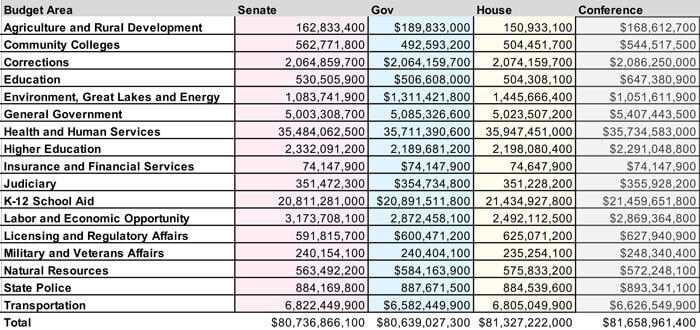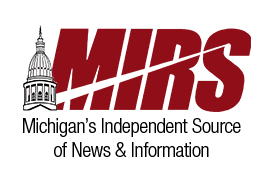(Source: MIRS.news, Published 06/28/23) More than $87 billion in state spending for this fiscal year and next – making up 1,600 pages of bill text – was revealed in a joint House-Senate appropriations subcommittee a little after 3 p.m. Wednesday and then passed by both the House and Senate without changes around 10 p.m.
The product of several weeks of secret negotiations, an $81.66 billion spending plan for the fiscal year starting Oct. 1 was combined with $6 billion in additional spending for the current fiscal year and spending approvals for the Natural Resources Trust Fund to account for the most money approved by the Michigan legislature in state history. From its unveiling to its final passage, the process took about seven hours.
The $81.66 billion Fiscal Year (FY) 2024 budget is 3% larger than last year's and larger than the spending proposals put out by the Governor ($80.7 billion) or passed in either the House ($81.32 billion) or the Senate ($80.73 billion).
”This budget is a Christmas right before July," said Rep. Rachel Hood (D-Grand Rapids).
While it tucks $200 million into the Rainy-Day Fund and another $450 million into a new School Aid Fund savings account, it also spends well over $1 billion on hundreds of specific pork projects across the state that are peppered throughout the budget.
Michigan is seeing an unprecedented amount of federal money for COVID relief and infrastructure investments to spend and a noticeable uptick in tax revenues, and lawmakers nearly spent it all in this budget.
“As one of my esteemed colleagues said, you better believe it. This is Christmas in July. This is bloat. This is pork. This is special interests. This is pet projects,” said Rep. Jay Deboyer (R-Clay). “It's 96,000 miles in size and it's one-inch deep.”
According to the state Budget Office, roughly $400 million will remain on the spending sheet for the General Fund and $220 million in the School Aid Fund once it's passed and signed into law, as is expected. Lawmakers are planning to adjourn this week for their summer recess.
Still, the budget received bi-partisan support in both chambers. The “Big Bus” passed the Senate, 26-10, and the House, 61-47. It received the two-thirds support needed in the Senate to make the bill go into effect by Oct. 1, the start of the next fiscal year.
The Senate Republicans' lead on the budget, Sen. Jon Bumstead (R-North Muskegon), voted for the School Aid Fund portion of the budget in this afternoon's conference committee. The House Republicans' lead, Rep. Sarah Lightner (R-Springport), passed on voting in conference committee, but voted for both budgets on the floor.
"Regardless of which side of this chamber you sit on, no budget is perfect, and this budget is no exception. It spends too much in gross state government, it all but eliminates our record surplus . . . but unlike the budget that the first chamber passed, it does incorporate many of the Republican priorities,"Sen. Jon Bumstead (R-North Muskegon), minority vice chair of the Senate Appropriations Committee, said on the Senate floor.
Bumstead said the omnibus budget approved today for FY '24 pays down debt, eliminates tuition increases at Michigan's universities and community colleges and makes the state's schools and neighborhoods safer. Ultimately, he said the budget-making process has come a long way from Democratic senators rejecting Republicans' more than 170 amendments to the chamber's initial round of budget votes in May.
The public saw details of the budget for the first time at 3 p.m. today. The House Fiscal Agency's analysis on the main "Big Bus" Omnibus spending bill (HB 4437) totaled 220 pages. The "School Bus" (SB 173) clocked in at 63 pages in just the analysis.
The Senate Fiscal Agency had 144 pages of analyses in their two documents.

Several Republicans say they were objecting to the bills because of the speed with which they passed the chambers.
Wednesday, Lansing was experiencing another day of unhealthy air quality due to smoke blown across the northern border from the Canadian wildfires.
“Maybe it's fitting that they're forcing through a smoke-filled budget in the middle of a smoke-filled weather,” said Sen. Jim Runestad (R-White Lake).
“It is perplexing what just took place tonight,” said House Speaker Joe Tate (D-Detroit). "We have 47 House Republicans who shirked their responsibility to fund the government. That means defunding the police. That means no mental health supports for Michiganders. That means no infrastructure funding to fix roads, lead service lines." It's unfortunate."
Not everyone got exactly what they wanted, but with more money coming into state coffers from federal and state taxes than Michigan has ever seen before, there was seemingly more than a little bit for everybody.
The Senate didn't get the $500 million it wanted for its Michigan Partnership Initiative and the Governor didn't get even more money for the Strategic Outreach and Attraction Reserve (SOAR) Fund.
Instead, the budget includes a brand-new $336 million "Make It In Michigan Competitive Fund," which officials will use to match federal dollars to fund infrastructure, health and public safety projects.
The bulk of the money ($286 million) was put in the Department of Technology, Management and Budget spending plan for next year while another $50 million was put in the current budget for this year.
Roughly $800 million is going to more than 200 individual projects through specialty grants to specific entities, a barrel of pork that blows the lid off any budget prior.
The grants for specific police stations and talent initiatives and splash pads and playgrounds and roads and housing and warming centers and museums and theaters and the like are on top of nearly $200 million in similar health care grants in the Department of Health and Human Services (DHHS) budget or some road-funding grants in the Transportation budget.
And these don't include $40 million for more affordable housing in Lansing or $40 million to modernize Lansing's administration campus or $40 million to build a new dorm at the Michigan School for the Deaf or $5 million to restore the historic pool at Moore's Park in Lansing.
Or the $332 million in grants in the transportation budget to fix specific bridges, roads and other transportation projects throughout the state, including $20 million for the Downriver rail separation project and a pair of bridges at Grosse Ile and Belleville.
In the DHHS budget, nearly $80 million in behavioral health funding for 23 specific and mostly regional programs was added, more than the $13.6 million the Governor wanted, the $64.2 million the House wanted and the $55.4 million the Senate wanted.
Also, $51.8 million in 18 specific public health programs were added after the House suggested $27.9 million and the Senate $20.8 million.
And $57 million in 15 one-time health services and programs were added for hospital and clinic upgrades in specific areas of the state.
The initial aggressive plans for lead service line replacement were scaled back from $200 million to $9.4 million. Likewise, a $100 million contaminated site cleanup proposal the Governor rolled out in February was moved back to $20 million.
In the K-12 budget, the foundation allowance is being increased by 5%, special education is getting $310 million more and $225 million is going toward helping teachers repay their student loans.
At-risk districts are getting $204 million more with a higher priority put on districts that need it more.
Other highlights include:
- $46 million to implement the voting reform changes and financial disclosure requirements required under last year's Proposal 1 and Proposal 2. Initially, the Governor had $16.2 million set aside. Now, the conference committee includes funding for 20 new employees to handle the workload.
- Counties, cities, villages, and townships are all getting a combined 7% funding increase -- 5% as an ongoing increase and 2% specifically for public safety initiatives.
- Direct care workers are getting an 85-cent-an-hour raise, which is lower than the $1.50-an-hour increase the Governor wanted or the $2.50-an-hour hike the House proposed, but higher than the 65 cents the Senate recommended.
- Non-clinical nursing staff at long-term care centers will also get an 85-cent-an-hour raise. The Governor proposed $3.85 an hour. The House didn't recommend anything and the Senate suggested $3.
- The $58 million the Governor wanted for the Coronavirus Task Force on Racial Disparity Initiatives was rolled back to $11 million for community health programs and $38.5 million for healthy food and community health programs.
- The Pure Michigan tourism advertising program was trimmed from $40 million to $25 million.
- $5.1 million is going toward the additional security needed to implement a weapon ban inside the Capitol.
- $40 million to forgive the outstanding debt of distressed school districts didn't make it. Neither did the request for $20.3 million to forgive Highland Park for its overdue water bills.
- Community colleges are receiving a 4.9% increase in their state foundation allowance. The universities are seeing a 6.4% increase with more than $100 million more coming from the School Aid Fund.
- The Governor wanted $10 million to turn the state's fleet into electric vehicles. She got $1 million.

